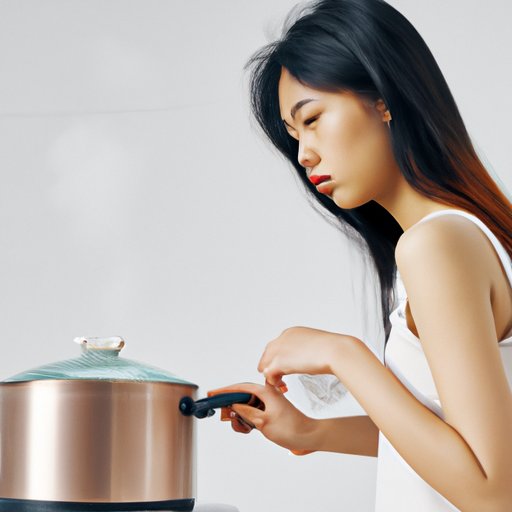How to Use a Steamer: A Comprehensive Guide
Steaming is an excellent method of cooking that preserves the nutritional value and flavor of foods. It’s also an effective way to clean fabrics, sanitize surfaces, and even remove wallpaper. If you want to learn how to use a steamer, this guide will provide you with all the necessary information.
How to Use a Steamer
Before getting started, you need a few items to steam:
- A steamer basket, pot, or steamer appliance
- A lid that fits the pot or appliance
- Water
Once you have these items, follow the steps below:
- Add water to the pot or appliance according to the manufacturer’s instructions, usually indicated on a fill line.
- Place the steamer basket or tray inside the pot or appliance.
- Add the food you want to steam to the basket or tray. Cutting it into even pieces helps ensure that it cooks evenly.
- Cover the pot or appliance with the lid, making sure to leave a small vent for steam to escape.
- Turn on the stove or appliance and let the steam build up for a few minutes.
- For vegetables, steam them for 3-10 minutes, depending on the type and how firm you want them. Meat and fish typically take longer, anywhere from 10 to 30 minutes.
- Check the food periodically, making sure it’s cooked through and maintaining the appropriate textures.
- Once the food is steamed to your liking, turn off the stove or appliance and carefully remove the lid to avoid burns from the remaining steam.
One essential thing to keep in mind is to maintain the water level in the pot. Running out of water while steaming can cause the pot or appliance to burn and potentially cause a fire. Steaming times will depend on the food you’re preparing and personal preferences. Here’s a list of commonly steamed foods:
- Vegetables: Broccoli, cauliflower, carrots, asparagus, green beans, brussels sprouts, and more.
- Fish: Salmon, cod, trout, tilapia, halibut, and more.
- Meat: Chicken breasts, pork chops, ground meat, and more.
- Dumplings: Potstickers, gyoza, shumai, and more.
- Grains: Rice, quinoa, couscous, and more.
- Eggs: Hard-boiled eggs are easy to make in a steamer.
As for seasoning and preparation, you can add salt, herbs, and spices to your food before steaming. To enhance the flavor, you can drizzle a little oil or soy sauce over the food after cooking. In some cases, you may want to marinate the food before steaming.
Benefits of Using a Steamer
The benefits of using a steamer go beyond food preparation. Here are some advantages to consider:
- Preserves nutrients: Steaming is a gentle cooking method that preserves the nutrients in food, such as vitamins and minerals, that are lost during other cooking methods.
- Reduces the need for oils or fats: Steaming doesn’t require any added oil or fat, making it a healthier way of cooking.
- Fast and easy: Steaming is a quick and easy way to cook food. You can prep the food and let the steam do the work, with little risk of overcooking or burning.
Cleaning and Maintaining a Steamer
Maintaining a steamer is relatively easy, but it’s important to keep it clean and maintained. Here are some tips:
- To remove mineral deposits from a steamer, fill the pot with equal parts water and vinegar, then boil and let sit for an hour. Rinse thoroughly afterward.
- For electric steamers, follow the manufacturer’s instructions for cleaning, typically involving wiping down the appliance after use and periodically deep cleaning it.
- Replace any damaged or worn-out parts, such as steamer baskets or seals, as soon as possible.
Types of Steamers Available
There are different types of steamers available, and which one to choose depends on your needs and preferences:
- Stove-top steamers: These steamers fit inside a pot that you place on your stove. They’re relatively inexpensive and suitable for basic steaming of vegetables, grains, and eggs.
- Electric steamers: These plug-in appliances consist of a base unit that heats the water and an upper compartment with the steamer tray. They’re more expensive than stove-top steamers but provide more cooking functions and can steam larger quantities of food.
- Handheld steamers: These steamers are mainly used for cleaning fabrics and disinfecting surfaces. They’re not suitable for cooking food and work by emitting steam through a nozzle when you hold them over the object you want to clean or sanitize.
The pros and cons of each type of steamer vary, so it’s best to research thoroughly before making a purchase.
Troubleshooting Guide
Using a steamer can be straightforward, but some issues may arise, such as:
- The food comes out too soggy: This can happen if you’re overcooking the food or not draining it properly before serving. Try reducing the steaming time or patting off excess moisture after cooking.
- Steam escaping around the lid: Make sure the lid is secure and that there’s adequate space for the steam to escape.
- Burnt or discolored steamer basket or tray: If this happens, it’s likely due to mineral buildup from hard water. Follow the cleaning instructions outlined earlier or use distilled water for steaming instead.
Using a Steamer for Household Tasks
Steamers can do more than just cook food. Here are some additional uses for a steamer:
- Cleaning fabrics: A steamer can help remove wrinkles and freshen fabrics, such as curtains, upholstery, and clothes.
- Sanitizing surfaces: Steam can kill germs and bacteria, making it an effective way to sanitize surfaces and objects, such as countertops, cutting boards, and toys.
- Removing wallpaper: A steamer can help loosen stubborn wallpaper, making it easier to remove without damaging the wall or leaving a sticky residue.
Conclusion
Steaming is an easy and healthy way to cook food and get other household tasks done. From steaming broccoli to cleaning curtains, steamers are versatile appliances that are worth having in your home.
